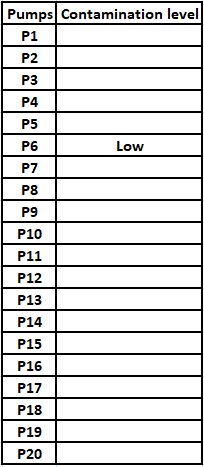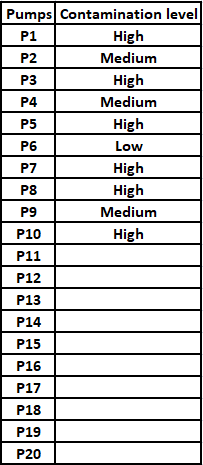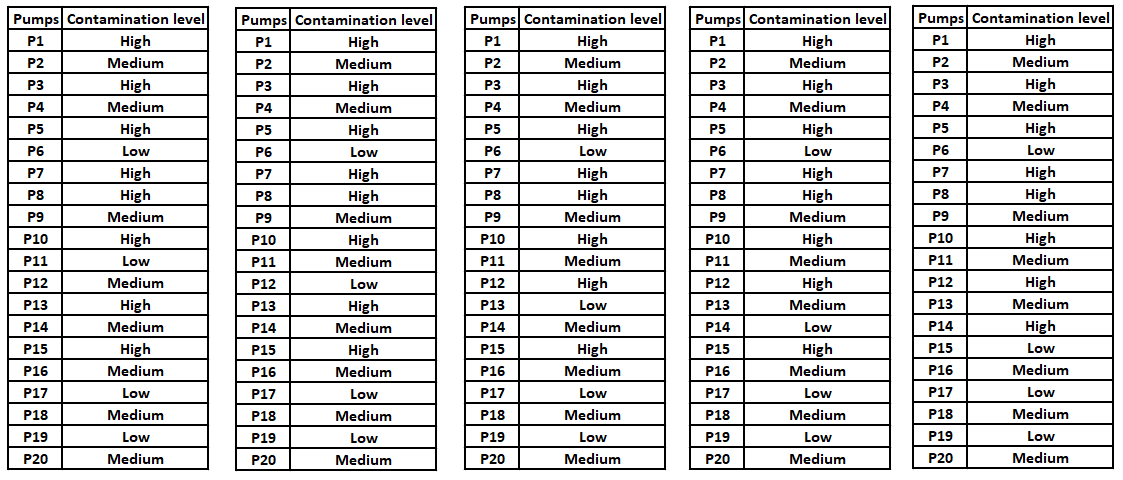Fuel contamination levels at each of 20 petrol pumps P1, P2, …, P20 were recorded as either high, medium, or low.
1. Contamination levels at three pumps among P1 - P5 were recorded as high.
2. P6 was the only pump among P1 - P10 where the contamination level was recorded as low.
3. P7 and P8 were the only two consecutively numbered pumps where the same levels of contamination were recorded.
4. High contamination levels were not recorded at any of the pumps P16 - P20.
5. The number of pumps where high contamination levels were recorded was twice the number of pumps where low contamination levels were recorded.
What best can be said about the number of pumps at which the contamination levels were recorded as medium?
Let us draw the table and fill all absolute information present.

In statement 3, it is given that P7 and P8 were the only two consecutively numbered pumps where the same levels of contamination were recorded.
In statement 1, it is given that contamination levels at three pumps among P1 - P5 were recorded as high. This is only possible when pumps 1, 3 and 5 have high level of contamination. Also, P6 was the only pump among P1 - P10 where the contamination level was recorded as low. Therefore, we can say that pumps 2 and 4 have medium level of contamination.

It is given that High contamination levels were not recorded at any of the pumps P16 - P20. Therefore, we can say that High contamination was recorded in only first 15 pumps. Therefore, we can say that the maximum number of pumps that can have high contamination level is '8'. (Consecutive pumps don't have same contamination level except one case)
Also, it is given that the number of pumps where high contamination levels were recorded was twice the number of pumps where low contamination levels were recorded. Hence, we can say that the number of pumps that have high contamination level is an even number less than or equal to '8'.
If the number of high contamination level pumps is '6', then there will be only '3' pumps with low contamination level. Consequently, we will need 11 (20 - 6 - 3) pumps with medium contamination level which is not possible since the number of pumps of a single type can't exceed 10.(Consecutive pumps don't have same contamination level except one case)
Therefore, we can say that the number of pumps that have high contamination level = 8
The number of pumps that have low contamination level = 8/2 = 4
Also, the number of pumps that have medium contamination level = 20 - 8 - 4 = 12
It is given that P7 and P8 were the only two consecutively numbered pumps where the same levels of contamination were recorded. If P7 and P8 recorded medium contamination level then there can be at max 7 pumps (P1, P3, P5, P9, P11, P13, P15) with high contamination level. Hence, we can say that pumps P7 and P8 recorded High contamination level. Therefore, we can uniquely determine the contamination level till P10.

It is given that High contamination levels were not recorded at any of the pumps P16 - P20. Therefore, we can say that these 5 pumps recorded low and medium contamination level. There are two cases possible.
Case 1: When there were 3 Low and 2 Medium contaminated level recorded in pumps P16 - P20.
3 Low contamination level must have recorded in P16, P18 and P20. We can fill the table as follows.

Case 2: When there were 2 Low and 3 Medium contaminated level recorded in pumps P16 - P20.
3 Medium contamination level must have recorded in P16, P18 and P20. We can fill the table as follows.

We know that medium contamination level was recorded at exactly 8 pumps. Hence, option C is the correct answer.
Video Solution

Create a FREE account and get:
- All Quant CAT complete Formulas and shortcuts PDF
- 38+ CAT previous year papers with video solutions PDF
- 5000+ Topic-wise Previous year CAT Solved Questions for Free




